________________
234
THE INDIAN ANTIQUARY.
[AUGUST, 1884.
a great deal of method and obvious accuracy. The following extracts are from Mr. M'Crindle's translation. The principal ports mentioned are Barugaza, the modern Bharoch, on the Narmada; Barbarikon, on the Indus; Mouziris (Mangalor), and Nelkunda (south of Mangalor), both the last being on the coast of Malabar. First, as regards the exports : Indian iron and sword blades were exported from Arabia to Adouli in Africa. Indian iron is mentioned in the Pandects as an article of commerce, and the Arabian poets celebrate swords of Indian steel-as well they might, since the material of the famous Damascus blades was wuta, which was manufactured in an obscure village in the Haidarâbâd territory." From the ports of Moaziris and Nelkunda gems in great variety were exported; but these, it is expressly stated, were not produced in India, but were brought from Taprobane or Ceylon. They probably consisted of the varieties of what we now call corundum, viz., sapphire, ruby, &c. Separately, the Adápas is mentioned as being sent from these ports, and it seems probable that under this title we may understand that diamonds, the production of Indian mines, are referred to.
From Barbarikon, on the Indus, a stone called kalcavòs was exported. It has been suggested that gold stone or chrysolite was indicated by this name. I cannot think that this is likely to be correct. Chrysolite of value is not, so far as we know, a product of that region; more probably, as has been suggested by Dana, it was turquoise, or an allied mineral now called callianite. If this identification be correct, it probably came through Afghanistan from Persia—the most famous known source of it being at Amsar, near Nishapur in Khorasan. Its occurrence anywhere nearer is extremely doubtful."
From Barugaza to Egypt vast quantities of 'Ovuxen were exported. They reached the sea port from Ozene and Paithana, the modern Ujjain in Málwa, and Paithan in Haidarâbâd. These are still known as the principal sources, among many, where pebbles of onyx and other Chalcedonic minerals are obtained from the detritus of the Dekhan basalt. The famous
* Vide Economic Geology, p. 340. 30 Economic Geology, p. 485.
31 Economic Geology of India, p. 502, where numerous references and a full account of the trade will be found.
Mouppim, which fetched extravagant prices** in the Roman markets, was also obtained in Ozene and exported from Barugaza.
Regarding the identity of this substance, Hermann Müller, as quoted by Mr. M'Crindle, remarks "Six hundred writers emulously applying themselves to explain what had the best claim to be considered the Murrha of the ancients, have advanced the most conflicting opinions. Now it is pretty well settled that the Murrhine vases were made of that stone which is called in German flusspath (spato fluore)." In spite of a desire not to augment this intolerable number of opinions, I must register an objection to this judicial decision of Professor Müller. Fluor-spar happens to be, though so common a mineral in other countries, of the very greatest rarity in India, and there is no record of its occurrence in the Dekhan basalts. It is, moreover, a mineral which, while it is susceptible of being made into ornamental objects, is, from its softness, easily injured by wear and tear, and therefore possesses little durability. On the other hand, at Ujjain, a great variety of Chalcedonic minerals are found, and I therefore prefer to follow those of the six hundred writers who have identified one or other of its varieties with the ancient murrha. At the present day cups and vases of carnelian, agate, &c., are obtainable in Bombay; and I think it most improbable that the modern Akiks, or lapidaries, who are the direct descendants of those who made the murrhine cups 2,000 years ago, ever saw, much less worked, the mineral called fluor-spar.
Another argument in support of this identification has been urged by some writers; it is that stone cups and vases, and fragments of them which have been obtained in excavations at Rome, have, on examination, proved to be of this material. None of fluor-spar are recorded.
The Zánpetpos was, we are told, exported from Barbarikon. If this were the true sapphire of modern times, its export from the most northern port, and, therefore, furthest from the recognised sources of the stone, would in itself be difficult to explain. It has been, however, clearly shown by King (Precious Stones) and
* Noro gave for one 300 talents, = £58,125. They were first seen at Rome in the triumphal procession of Pompey.




